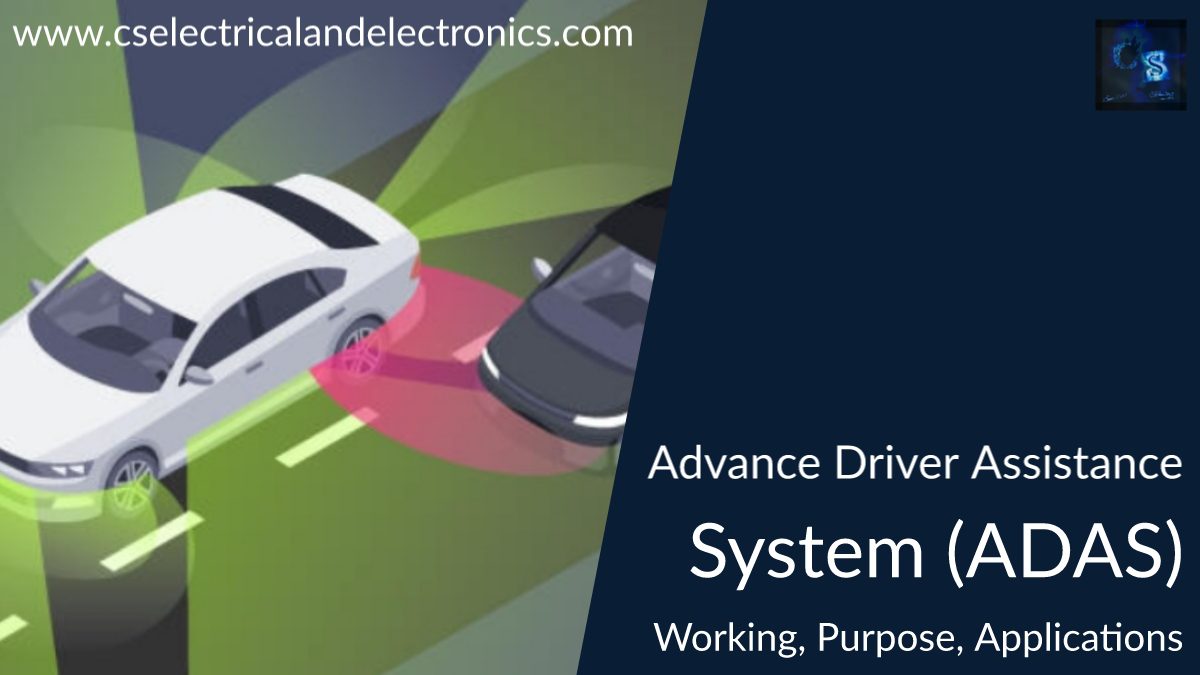What Is Advanced Driver Assistance System (ADAS), Applications
Hello guys, welcome back to our blog. Here in this article, I will discuss what is advanced driver assistance system (ADAS), the applications of ADAS, the working of advanced driver assistance systems, and why it is needed.
If you have any electrical, electronics, and computer science doubts, then ask questions. You can also catch me on Instagram – CS Electrical & Electronics.
Also, read:
- Why To Learn AUTOSAR, Purpose, Applications Of AUTOSAR
- What Is Volatile Keyword In C, Why It Is Used, Example Code
- Difference Between I2C And SPI Protocol, Which Is Best Protocol
Advanced Driver Assistance System (ADAS)
Advanced Driver Assistance Systems (ADAS) are electronic systems that are designed to assist drivers in various ways to improve the safety and efficiency of their vehicles. These systems use sensors, cameras, and other technologies to monitor the vehicle’s surroundings and provide the driver with information and assistance in a variety of situations. Some common examples of ADAS include:
- Lane-keeping assistance: This helps the driver to stay in their lane by providing steering inputs or warning sounds when the vehicle begins to drift.
- Adaptive cruise control: This allows the vehicle to maintain a safe distance from other vehicles by automatically adjusting its speed based on the speed of the vehicle in front of it.
- Blind spot monitoring: This uses sensors to detect vehicles in the driver’s blind spot and alerts the driver with a visual or auditory warning.
- Automatic emergency braking: This uses sensors to detect potential collisions and automatically applies the brakes to reduce the severity of the impact or avoid it altogether.
- Park assist: This helps the driver to park their vehicle in a parallel or perpendicular space by providing steering inputs or warning sounds.
ADAS can be found in a variety of vehicles, including passenger cars, trucks, and buses. These systems can improve safety on the road and help to reduce the number of accidents and fatalities.
Working of Advanced Driver Assistance Systems (ADAS)
Advanced Driver Assistance Systems (ADAS) use a combination of sensors, cameras, and other technologies to monitor the vehicle’s surroundings and provide the driver with information and assistance in a variety of situations.
- Sensors: ADAS systems use various types of sensors, such as radar, lidar, and ultrasonic sensors, to detect objects and obstacles in the vehicle’s surroundings. These sensors can detect the presence and distance of other vehicles, pedestrians, and other objects.
- Cameras: ADAS systems may also use cameras to capture images of the vehicle’s surroundings and provide the driver with a visual representation of the environment.
- Processing: The sensor and camera data is processed by a computer, which uses algorithms to analyze the data and identify potential hazards or situations that require the driver’s attention.
- Assistance: Based on the analysis of the sensor and camera data, the ADAS system can provide the driver with information and assistance in various ways, such as displaying warning messages, providing steering inputs, or applying the brakes.
Overall, the goal of ADAS is to improve the safety and efficiency of driving by providing the driver with information and assistance in a variety of situations. These systems can help to reduce the number of accidents and fatalities on the road.
Why to use Advanced Driver Assistance Systems (ADAS)
There are several reasons why Advanced Driver Assistance Systems (ADAS) can be useful for drivers:
- Improved safety: ADAS systems can help to improve safety on the road by providing the driver with information and assistance in a variety of situations. For example, lane-keeping assistance can help the driver to stay in their lane, adaptive cruise control can help the driver to maintain a safe distance from other vehicles, and automatic emergency braking can help to reduce the severity of a collision or avoid it altogether.
- Enhanced convenience: ADAS systems can also provide drivers with enhanced convenience by taking care of certain tasks automatically. For example, park assist can help the driver to park their vehicle in a tight space, and the adaptive cruise control can help the driver to maintain a consistent speed on the highway.
- Reduced fatigue: ADAS systems can help to reduce driver fatigue by taking over certain tasks, such as lane keeping or maintaining a consistent speed, which can allow the driver to relax and stay alert.
- Improved fuel efficiency: ADAS systems can also help to improve fuel efficiency by optimizing the vehicle’s speed and acceleration based on the surrounding traffic and road conditions.
Overall, ADAS systems can provide drivers with a range of benefits that can improve the safety, convenience, and efficiency of their driving experience.
This was about “Advanced Driver Assistance System (ADAS)“. I hope this article may help you all a lot. Thank you for reading.
Also, read:
- 100 + Electrical Engineering Projects For Students, Engineers
- 1000+ Automotive Interview Questions With Answers
- 1000+ Electronics Projects For Engineers, Diploma, MTech Students
- 1000+ MATLAB Simulink Projects For MTech, Engineering Students
- 50 Advanced Level Interview Questions On CAPL Scripting
- 500+ Embedded System Projects For Engineer, Diploma, MTech, PhD
- 500+ Projects For Diploma Electrical, Electronics Student, Diploma Project
- 8051 Microcontroller Timers, TCON Register, TMOD Register

